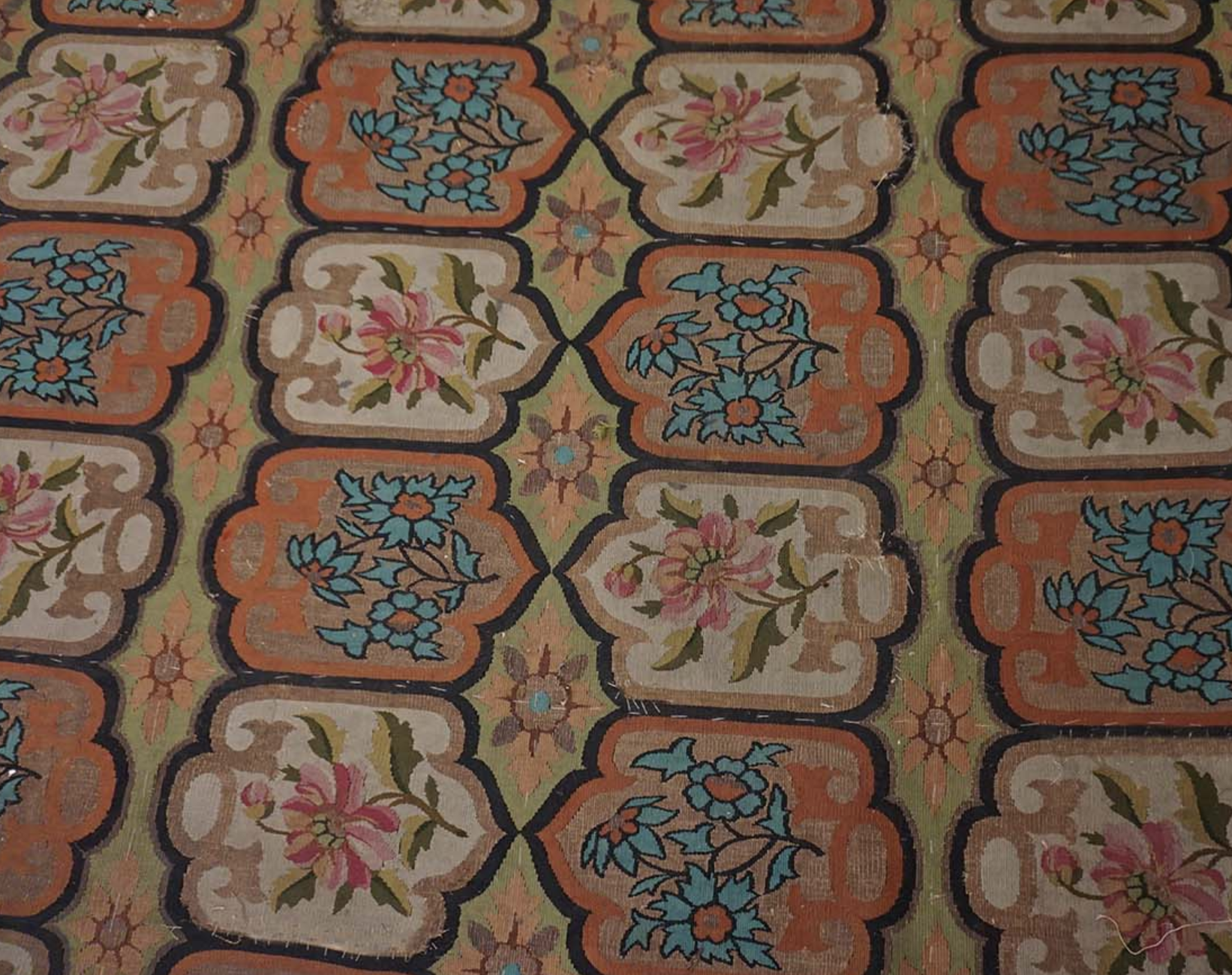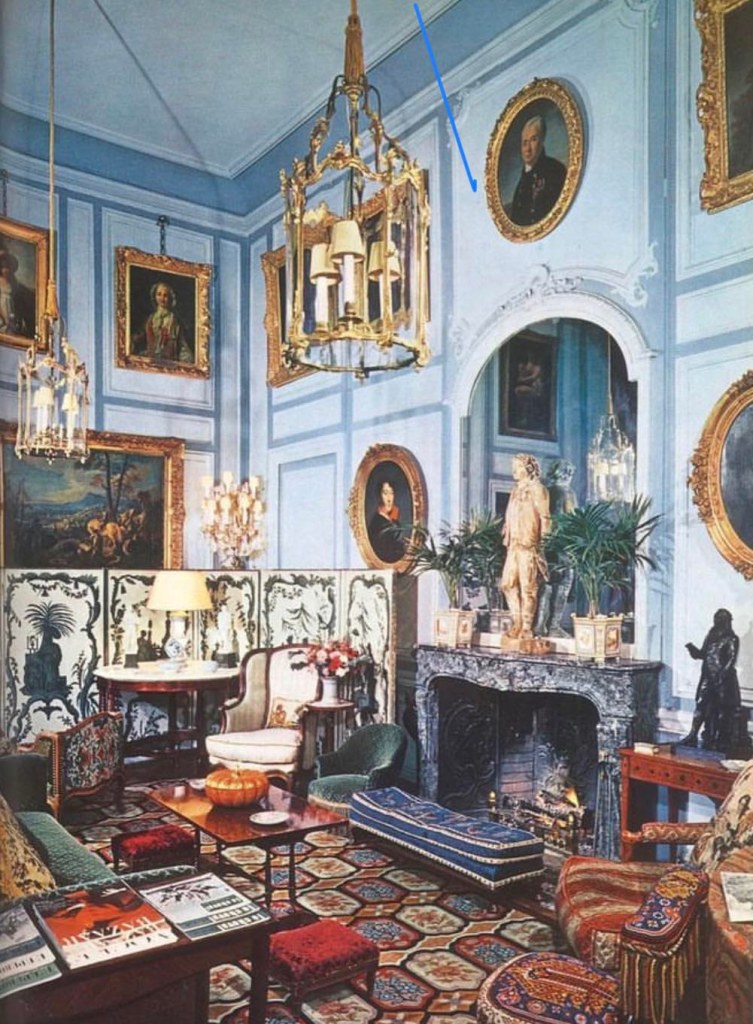 Rug #17577
Rug #17577
Aubusson Carpet
France, Aubusson Workshops
Size: 15’6” x 25’6”
Period: Directoire, 1797-1804
Structure:
warp: wool, tan to light brown, natural, Z-2-S, 8/in.
weft: wool, Z-2-S, 24/in
technique: slit tapestry
This flatweave carpet is a fine example of the relatively short-lived “Pompeian” style with purely two-dimensional surface decoration popular in the years after the French Revolution, but before Napoleons’ grandiose imperial aspirations. The open, classicizing ornament in distinct panels is an adaptation at several removes of wall frescoes discovered at Pompeii in the later 18th century which came as a revelation to European designers who, except for the grotesques of the Golden House of Nero in Rome, had no experience of classical wall décor. The light, airy, spare, elegant patterns were first promulgated in France by Percier le’Fontaine, particularly for furniture and objects, and were then interpreted by designers working for the major Aubusson workshops. The artists include Koby, la Segliere Desfarges, Lagremee, Dubois, Barraband and most prominently Harmayde de Saint-Ange, the most innovative of the lot. Unfortunately signed cartoons or sketches by these artists do not seem to have survived in any significant quantity and one cannot attribute particular carpets to individual artists. But our piece is surely the work of one of these designers.
The period of popularity of the Pompeian style was quite short. The Revolution abruptly cut off what was in the 1780s a steadily increasing demand for Aubusson rugs of all types. May workshops closed so that by 1796 the local industry was at such a low evv that unemployed workers were rioting and a military regiment had to be garrisoned in town to prevent looting. Thus, the style has to begin after that time as there is a radical break with what went before.
 After 1804 style quite rapidly changes from Directoire neo-classical chasteness to the much heavier full Empire style with thick wreaths and garlands, military elements in abundance, and so obvious Imperial symbols, more three dimensional and generally richer and opulent appearance. Thus our piece, of purely Pompeian character may securely be dated circa 1800.
After 1804 style quite rapidly changes from Directoire neo-classical chasteness to the much heavier full Empire style with thick wreaths and garlands, military elements in abundance, and so obvious Imperial symbols, more three dimensional and generally richer and opulent appearance. Thus our piece, of purely Pompeian character may securely be dated circa 1800.
It must be noted parenthetically that much of Aubusson production, especially after 1800 when a workshop was set up in Paris in the Marais district by Sallandrouze de Mornaiz, who previously operated only in Aubusson, to make pile carpets, is in full knotted structure and so it is incorrect to call all French, pile rugs Savonneries. Sallandrouze became the leading merchant-entrepreneur in Aubusson, often collaborating with another dealer, Kegier. He certainly had the resources to make rugs of any size and it is not impossible that our carpet may have some connection with him. A third shop, that of Debel was also active in Aubusson at this time and his may be another candidate for its source.
By 1807 an improving economic situation had drawn other businesses to Aubusson and shops were owned by F. Roby, P. Maingonnat, L. Fournier, F. Desfarges, J. Peyroux and especially Bellanger & Vayson, but these are too late for our piece. Unlike Brussels or Antwerp tapestries, pieces are not market to indicate workshops and the few designs do not have factory indications.
After 1806 Rogier & Sallandrouze were busy with many court commissions for pile rugs and the designer Saint-Ange who supplied them with designs had shifted to the heavier Empire style, but before that date that combination could be the source of our rug. But any of the other designers could have done the work as well. Thus Jarry gives neither designer nor workshop in her book’s plate captions.
 As for a possible patron, the matter is inconclusive at best. It has been suggested that the rampant lion in the central square and the lion masks in the corner squares are quasi-armorial, referring to the possible patron or at least to his status. But there are many examples of this period where a pictorial motif appears in a setting of panel borders, geometric flowers, anthemion scrolls, garlands, rosettes, etc. with no external reference, and not just in rugs. In silks designed by Rony of c. 1800 from Lyon we find a cupid on one, a nymph on another, in precisely the same sort of paneled array, among exactly these same decorative elements. The same type of baguette with scroll ornaments and intermittent lozenges appears on another c. 1800 silk textile. Eagles and cryphons appear on rugs of the period in central devices or in border medallions. Similar border styles and ornamental panels with muchan or animal figures also appear on painted wallpaper of the period. A good selection of these designs appears in Les Nouvelles Collections de l’Union Centrale des Arts Decoratifs, 19th series, esp, pls. 85-7, 89, 91-2, 97, 106. Therefore the lion is most unlikely to be referential, but merely decorative, and could be replaced by any one of several other animals or other devices appropriate to a neo-classical design scheme.
As for a possible patron, the matter is inconclusive at best. It has been suggested that the rampant lion in the central square and the lion masks in the corner squares are quasi-armorial, referring to the possible patron or at least to his status. But there are many examples of this period where a pictorial motif appears in a setting of panel borders, geometric flowers, anthemion scrolls, garlands, rosettes, etc. with no external reference, and not just in rugs. In silks designed by Rony of c. 1800 from Lyon we find a cupid on one, a nymph on another, in precisely the same sort of paneled array, among exactly these same decorative elements. The same type of baguette with scroll ornaments and intermittent lozenges appears on another c. 1800 silk textile. Eagles and cryphons appear on rugs of the period in central devices or in border medallions. Similar border styles and ornamental panels with muchan or animal figures also appear on painted wallpaper of the period. A good selection of these designs appears in Les Nouvelles Collections de l’Union Centrale des Arts Decoratifs, 19th series, esp, pls. 85-7, 89, 91-2, 97, 106. Therefore the lion is most unlikely to be referential, but merely decorative, and could be replaced by any one of several other animals or other devices appropriate to a neo-classical design scheme.
The use of borders with prominent square corner elements is very characteristic of the period. The double panels at each end allows an otherwise square composition to be enlarged without changing the proportions of the central section. For a somewhat shorter rug a single extra panel at each end would suffice.
 The lion masks in the corners ensuite with the central beast provide a consistency of motif which again appears in any number of variants: musical instruments, classical military trophies, grapes (corners) and classical wine cup (centre), etc. (Cf. Nouvelles Colls. Pls. 88, 95, 100). Other animals in the center may include the peacock.
The lion masks in the corners ensuite with the central beast provide a consistency of motif which again appears in any number of variants: musical instruments, classical military trophies, grapes (corners) and classical wine cup (centre), etc. (Cf. Nouvelles Colls. Pls. 88, 95, 100). Other animals in the center may include the peacock.
Comparanda include:
Jarry, Carpets of Aubusson, fig. 35 and fig. 43. For a closely related (pile) Savonnerie, see Jarry, Savonnerie, fig. 58.
*Post written by Peter Saunders, edited for Rahmanan by Katrina Mauro

































